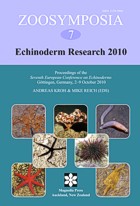Abstract
The black brittle star Ophiocomina nigra, common in the English Channel, is known to produce mucus when attacked. This mucus, already known for its antifouling capabilities and its role in the feeding and the locomotion behaviours of the brittle star, also emits weak light. We describe and characterize this emission of bioluminescence, thanks to a chemical triggering by hydrogen peroxide. It appears that the light emitted is 1000 times less intense than the light emitted by other brittle star species (Ophiopsila aranea and Amphipholis squamata). The luminous capabilities are homogeneously spread along the arms of the brittle star, what goes against the use of bioluminescence as a sacrificial lure. The mechanical stimulation of arms before chemical triggering strongly enhances the luminous capabilities of the brittle star. Luminous mucus emission can be associated with other defensive function, such as a smoke screen effect or a burglar alarm, but these two functions require intense light emissions. The fact that the luminous component is excreted outside the body might be in favour of the aposematic use of light, i.e., as a signal to warn predators of the toxicity or unpalatability of its prey.

